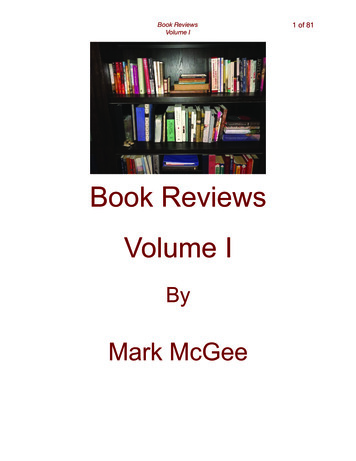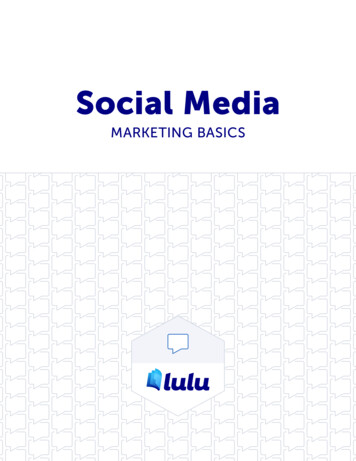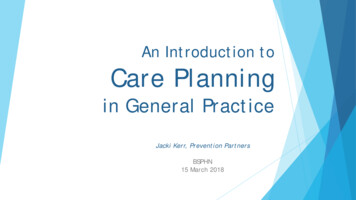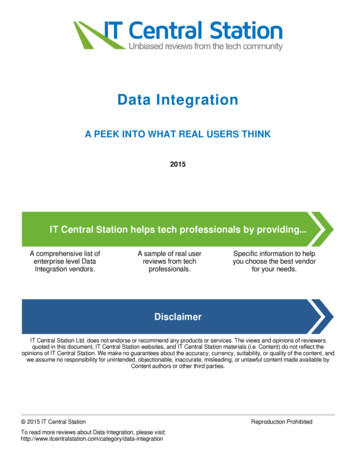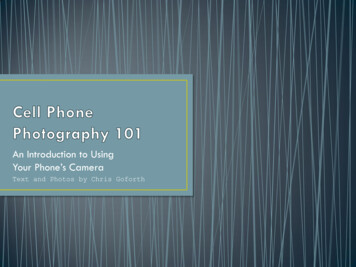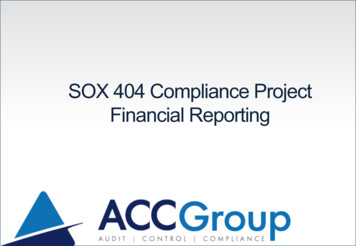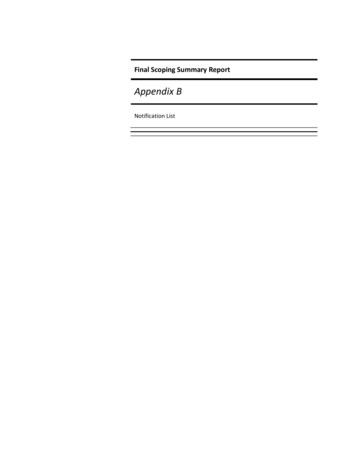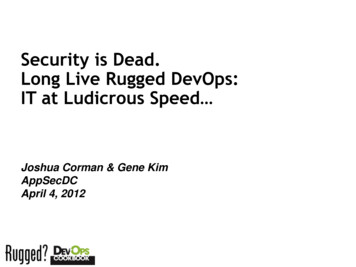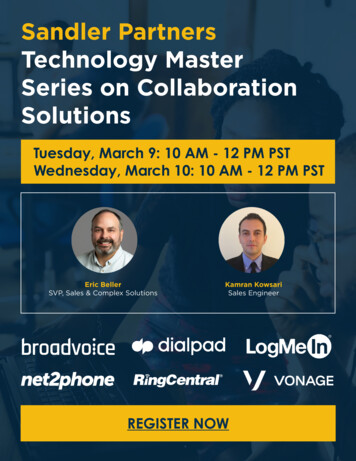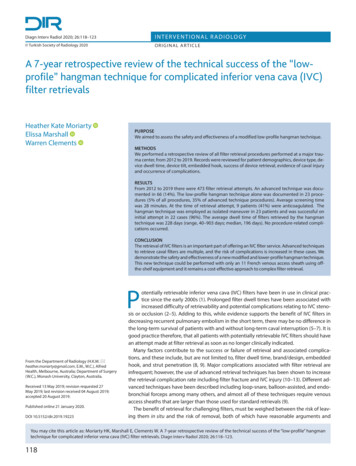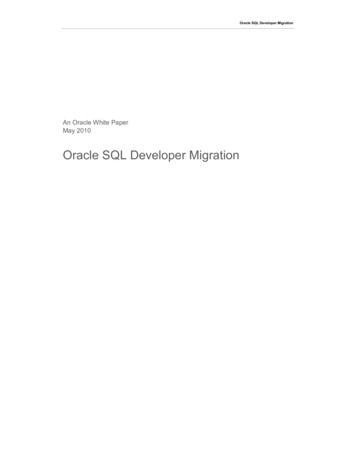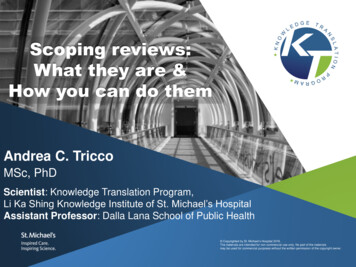
Transcription
Scoping reviews:What they are &How you can do themAndrea C. TriccoMSc, PhDScientist: Knowledge Translation Program,Li Ka Shing Knowledge Institute of St. Michael’s HospitalAssistant Professor: Dalla Lana School of Public Health Copyrighted by St. Michael’s Hospital 2016.The materials are intended for non-commercial use only. No part of the materialsmay be used for commercial purposes without the written permission of the copyright owner.
Conflicts of interest None to declare.2
Learning objectives1. Describe/explain what scopingreviews are and how they can beapplied.2. Discuss/examine differentexamples of scoping reviews.3. Describe the steps to follow whendoing a scoping review.Stuart Miles/freedigitalphotos.net3
What are scopingreviews?4
Types of knowledge syntheses1.Systematic reviews5. Rapid reviews2.Network meta-analysis6. Diagnostic reviews3.Scoping reviews7. Prognostic reviews4.Overview of reviews8. Economic reviewsPlus emerging methods5
Definition of a scoping review“Exploratory projects thatsystematically map the literatureavailable on a topic, identifyingkey concepts, theories, sourcesof evidence and gaps in theresearch”Canadian Institutes of Health Research, http://www.cihr-irsc.gc.ca/e/41382.html6
Why are scoping reviewshelpful to knowledgeusers?7
Why do a scoping review? (1)Arksey and O’Malley (2005) identified 4 reasons:1) To examine the extent, range and nature of available research on atopic or question2) To determine the value of undertaking a full systematic review3) To summarize and disseminate research findings across a body ofresearch evidence (e.g. that is heterogeneous and/or complex)4) To identify research gaps in the literature to aid planning andcommissioning of future research.Arksey H, O’Malley L. Scoping studies: Towards a MethodologicalFramework. Int J Soc Res Methodol. 2005; 8(1):19–32.8
Why do a scoping review? (2)Most common reasons for conducting ascoping review*, N 494Count (%)Explore breadth/extent of evidenceMap and summarize evidenceInform future researchIdentify knowledge gapsAddress knowledge gapsImplications for practice and policyAdvance knowledge/awarenessIdentify key themesDevelop a conceptual framework/mapNot reported336 (68%)177 (36%)103 (21%)84 (17%)55 (11%)41 (8%)28 (6%)22 (4%)15 (3%)22(4.4%)* Note, categories are not mutually exclusive.Tricco et al., 2016. 11/9
Why/how are scoping reviews useful? Help to clarify working definitions andconceptual boundaries of a topic. When a body of literature has not beencomprehensively reviewed, or exhibits alarge, complex, or heterogeneousnature.Peters et al., 2015. https://www.ncbi.nlm.nih.gov/pubmed/26134548, Tricco et al., 4746911/10
Examples of scopingreviews by our center11
https://www.ncbi.nlm.nih.gov/pubmed/2675392312
Key findings Examined barriers and facilitators to the use of systematic reviews(SR) by health care managers and policy makers, e.g. format andcontent, to develop recommendations for authors. Findings to inform the preparation of SR, including:o Provision of 1-page summaries with key messages, tailored to therelevant audience.o Creation of partnerships between researchers and policymakers/managers to facilitate the conduct and use of systematicreviews to enhance relevance of reviews and increase uptake. Used to inform 1-page policy brief used by CIHR13
Conducted for Health Canada, https://www.ncbi.nlm.nih.gov/pubmed/2810470914
Key findings (from upcoming manuscript) Aimed to characterize the literature on social media for detecting adverseevents (AEs) related to health products. Some encouraging results; social media data information extractionsystems can supplement data from regulatory agency databases, capturerare AEs and identify AEs earlier than the official alert. The utility, validation and implementation of social media data informationextraction systems remain under-studied. Used to inform Health Canada’s development of socialmedia platform15
16
Key findings Aimed to identify documents evaluating or comparing theeffectiveness of medical liability reforms and qualityimprovement strategies to improve litigation-related outcomes inobstetrics.o Only a few litigation policies were evaluated or compared. Initiatives to reduce medical malpractice litigation could beassociated with a decrease in adverse and malpractice events.o Given the heterogeneous settings and reported outcomes,the advantages and disadvantages of initiatives may vary. Used to inform litigation policy strategies in SouthAfrica17
Discussion questionCan anyone provide anexample of a scopingreview that they have doneor are currently workingon?18
Examples of non-healthrelated scoping reviews19
Example: scoping review in .00220
Example: scoping review in computer ?tp &arnumber 5974347&isnumber 597416221
Example: scoping review in housing 091 22
Doing a scoping review23
Overview of scoping review steps by the Joanna Briggs InstituteProtocol, title, background, reviewquestion(s) & objective(s)Eligibility criteria and comprehensivesearching to identify sources ofevidenceSelection of relevant sources ofevidence (screening)Extracting and charting the resultsConclusions and implicationsPeters et al., 2015. https://www.ncbi.nlm.nih.gov/pubmed/2613454824
Scoping review steps by the Joanna Briggs Institute1. Protocol: The protocol predefines the objectives andmethods and details theplans. It can be refined, asneeded (report any changes).1. Develop a protocol (apriori)How is the step operationalized inthe literature?Reported in 13% of N 494included scoping reviews inTricco et al., 2016Peters et al., 2015. https://www.ncbi.nlm.nih.gov/pubmed/26134548, Tricco et al.,2016. 11/
Scoping review steps by the Joanna Briggs Institute2. Review question/objective:The objective can be broad,guides the scope. The reviewquestion(s) should beconsistent with the title andinform the eligibility criteria.1. Develop a protocol (apriori)2. State your reviewquestion/objective clearlyHow is the step operationalizedin the literature?Reported in 97% of N 494included scoping reviews inTricco et al., 2016Peters et al., 2015. https://www.ncbi.nlm.nih.gov/pubmed/26134548, Tricco et al.,2016. 11/
Scoping review steps by the Joanna Briggs Institute3. Eligibility criteria: guidethe review, and used to makedecisions on the sources toinclude. The rationale for eachof the criteria should be clearlyexplained.1. Develop a protocol (apriori)2. State your reviewquestion/objective clearly3. Establish your eligibilitycriteria (with a rationale)How is the step operationalizedin the literature?Reported in 79% of N 494included scoping reviews inTricco et al., 2016Peters et al., 2015. https://www.ncbi.nlm.nih.gov/pubmed/26134548, Tricco et al.,2016. 11/
Scoping review steps by the Joanna Briggs Institute4. Searching databases: Thesearch strategy should becomprehensive. Detailpublication date & languagelimitations, with a rationale.1. Develop a protocol (apriori)2. State your reviewquestion/objective clearly3. Establish your eligibilitycriteria (with a rationale)How is the step operationalizedin the literature?Reported in 93% of includedscoping reviews in Tricco etal., 20164. Search 1 databasePeters et al., 2015. https://www.ncbi.nlm.nih.gov/pubmed/26134548, Tricco et al.,2016. 11/
Scoping review steps by the Joanna Briggs Institute5. Reference list scanning: Thereference lists of all identifiedsources should be searched foradditional sources.1. Develop a protocol (apriori)2. State your reviewquestion/objective clearly3. Establish your eligibilitycriteria (with a rationale)How is the step operationalizedin the literature?Reported in 56% of N 494included scoping reviews inTricco et al., 20164. Search 1 database5. Scan reference listsPeters et al., 2015. https://www.ncbi.nlm.nih.gov/pubmed/26134548, Tricco et al.,2016. 11/
Scoping review steps by the Joanna Briggs Institute6. Grey literature searching:If applicable to the reviewquestion/objective, includeunpublished literature (greyliterature) in your searchstrategy.6. Search grey literatureHow is the step operationalizedin the literature?Reported in 52% of N 494included scoping reviews inTricco et al., 2016Peters et al., 2015. https://www.ncbi.nlm.nih.gov/pubmed/26134548, Tricco et al.,2016. 11/
Scoping review steps by the Joanna Briggs Institute7. Level one screening:Screen titles and abstracts ofthe identified sources, ideallyby 2 or more reviewers(independently).6. Search grey literature7. Screen titles & abstracts (by 2reviewers)How is the step operationalizedin the literature?Reported in 36% of N 494included scoping reviews inTricco et al., 2016Peters et al., 2015. https://www.ncbi.nlm.nih.gov/pubmed/26134548, Tricco et al.,2016. 11/
Scoping review steps by the Joanna Briggs Institute8. Level two screening:Screen the full texts of theidentified sources, ideally by 2or more reviewers(independently).6. Search grey literature7. Screen titles & abstracts (by 2reviewers)8. Screen full-texts (by 2reviewers)How is the step operationalizedin the literature?Reported in 29% of N 494included scoping reviews inTricco et al., 2016Peters et al., 2015. https://www.ncbi.nlm.nih.gov/pubmed/26134548, Tricco et al.,2016. 11/
Scoping review steps by the Joanna Briggs Institute9. Charting form: record ofthe characteristics of theincluded studies and the keyinformation relevant to thereview question(s). Can refineas needed.6. Search grey literature7. Screen titles & abstracts (by 2reviewers)8. Screen full-texts (by 2reviewers)How is the step operationalizedin the literature?Reported in 43% of N 494included scoping reviews inTricco et al., 20169. Have a pre-defined chartingform (can refine it)Peters et al., 2015. https://www.ncbi.nlm.nih.gov/pubmed/26134548, Tricco et al.,2016. 11/
Scoping review steps by the Joanna Briggs Institute6. Search grey literature10. Charting: extract relevantdata from the includedsources, ideally by 2 or morereviewers (independently).7. Screen titles & abstracts (by 2reviewers)8. Screen full-texts (by 2reviewers)How is the step operationalizedin the literature?Reported in 30% of N 494included scoping reviews inTricco et al., 20169. Have a pre-defined chartingform (can refine it)10. Chart data (by 2 reviewers)Peters et al., 2015. https://www.ncbi.nlm.nih.gov/pubmed/26134548, Tricco et al.,2016. 11/
Scoping review steps by the Joanna Briggs Institute11. Present results: usediagrams, tables, and/or adescriptive format that alignswith the objective/reviewquestion(s).11. Present results indiagrams, or tablesHow is the step operationalizedin the literature?Reported in 83% of N 494included scoping reviews inTricco et al., 2016Peters et al., 2015. https://www.ncbi.nlm.nih.gov/pubmed/26134548, Tricco et al.,2016. 11/
Scoping review steps by the Joanna Briggs Institute12. Flow diagram: shows thedecision process, includingsearch results, selectionprocess results, additions fromreference searching, etc. andthe final number of includedsources11. Present results indiagrams, or tables12. Present flow diagramHow is the step operationalizedin the literature?Reported in 47% of N 494included scoping reviews inTricco et al., 2016Peters et al., 2015. https://www.ncbi.nlm.nih.gov/pubmed/26134548, Tricco et al.,2016. 11/
Scoping review steps by the Joanna Briggs Institute13. Research implications:Following the conclusion(s),identify recommendations forfuture research based on gapsidentified (including conduct ofa systematic review).11. Present results indiagrams, or tables12. Present flow diagram13. Identify implications forresearchHow is the step operationalizedin the literature?Reported in 84% of N 494included scoping reviews inTricco et al., 2016Peters et al., 2015. https://www.ncbi.nlm.nih.gov/pubmed/26134548, Tricco et al.,2016. 11/
Scoping review steps by the Joanna Briggs Institute14. Implications for practice:if applicable, depending on thefocus of the review, practiceimplications may be specified.11. Present results indiagrams, or tables12. Present flow diagram13. Identify implications forresearchHow is the step operationalizedin the literature?Reported in 54% of N 494included scoping reviews inTricco et al., 201614. Identify implications forpracticePeters et al., 2015. https://www.ncbi.nlm.nih.gov/pubmed/26134548, Tricco et al.,2016. 11/
Relevant work: scoping review methods Methods papers on scoping reviews:o A scoping review on the conduct and reporting of scoping reviews by Tricco et al.,https://www.ncbi.nlm.nih.gov/pubmed/26857112o Advancing scoping study methodology: a web-based survey and consultation ofperceptions on terminology, definition and methodological steps by O’Brien et al.,https://www.ncbi.nlm.nih.gov/pubmed/27461419 Upcoming reporting guideline:o An extension of the PRISMA statement is for scoping reviews is underway:PRISMA-ScR. uidelines-under-development/39
Polling questions40
Poll #1When doing a scoping review, should you plan to conducta meta-analysis?YesNoUnsure41
Poll #2When doing a scoping review, should you plan toappraise the risk of bias of included sources?YesNoUnsure42
Summary Scoping reviews are conducted to map the literature available ona topic in a systematic way. Scoping reviews are useful when an area of research is new oremerging, heterogeneous and/or complex. Scoping reviews can be conducted using the Joanna BriggsInstitute guidance.43
Learning Objectives1. Describe/explain what scopingreviews are and how they can beapplied.2. Discuss/examine different examplesof scoping reviews.3. Describe the steps to follow whendoing a scoping review.Stuart Miles/freedigitalphotos.net44
QuestionsDo you have any questionsabout today’s presentation?45
AcknowledgementsCanadian Institutes of Health Research Scoping review knowledge synthesis grantCanadian Agency for Drugs and Technologies in Health Scoping review reporting guideline grantCanada Research Chair in Knowledge Synthesis46
Acknowledgements Erin Lillie Wasifa Zarin Dr. Sharon Straus47
Thank you for your attention!Andrea C. Tricco MSc, PhDScientist, Knowledge Translation Program, Li Ka ShingKnowledge Institute of St. Michael's HospitalAssistant Professor, Dalla Lana School of Public Health,University of TorontoTier 2 Canada Research Chair in Knowledge SynthesisE-mail: triccoa@smh.ca48
References Anderson, Jalene Tayler, and Damian Collins. "Prevalence and causes of urban homelessness amongindigenous peoples: a three-country scoping review." Housing Studies 29.7 (2014): 959-976. Arksey H, O’Malley L. Scoping studies: Towards a Methodological Framework. Int J Soc Res Methodol.2005;8(1):19–32. Fernando Cruz Marta, A. M. R. Correia and Fátima Trindade Neves, "Supporting KMS through CloudComputing: A scoping review," 6th Iberian Conference on Information Systems and Technologies (CISTI2011), Chaves, 2011, pp. 1-6.URL: http://ieeexplore.ieee.org/stamp/stamp.jsp?tp &arnumber 5974347&isnumber 5974162 O'Flaherty, J., Phillips, C. The use of flipped classrooms in higher education: A scoping review, TheInternet and Higher Education, Volume 25, 2015, Pages 85-95, ISSN 02.002 Peters MD, Godfrey CM, Khalil H, McInerney P, Parker D, Soares CB. Guidance for conductingsystematic scoping reviews. Int J Evid Based Healthc. 2015;13(3):141–6. Tricco AC, Ashoor HM, Cardoso R, et al. Sustainability of knowledge translation interventions inhealthcare decision-making: a scoping review. Implementation Science : IS. 2015;11:55.doi:10.1186/s13012-016-0421-7. Tricco AC, Lillie E, Zarin W, et al. A scoping review on the conduct and reporting of scoping reviews. BMCMedical Research Methodology. 2016;16:15. doi:10.1186/s12874-016-0116-4. Tricco AC, Zarin W, Lillie E, et al. Utility of social media and crowd-sourced data for pharmacovigilance: ascoping review protocol BMJ Open 2017;7:e013474. doi: 10.1136/bmjopen-2016-01347449
How is the step operationalized in the literature? Reported in 97% of N 494 included scoping reviews in Tricco et al., 2016 2. Review question/objective: The objective can be broad, guides the scope. The
